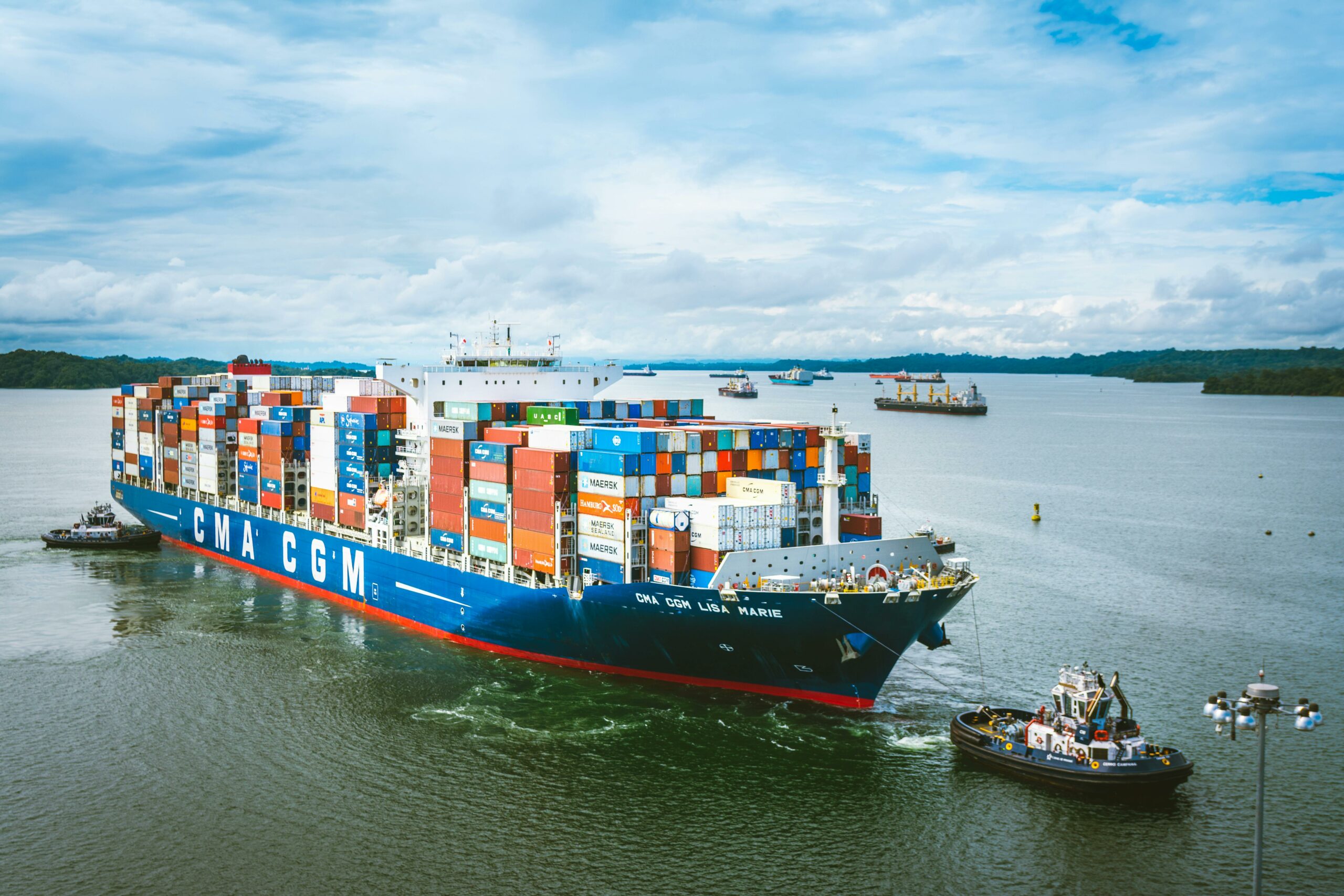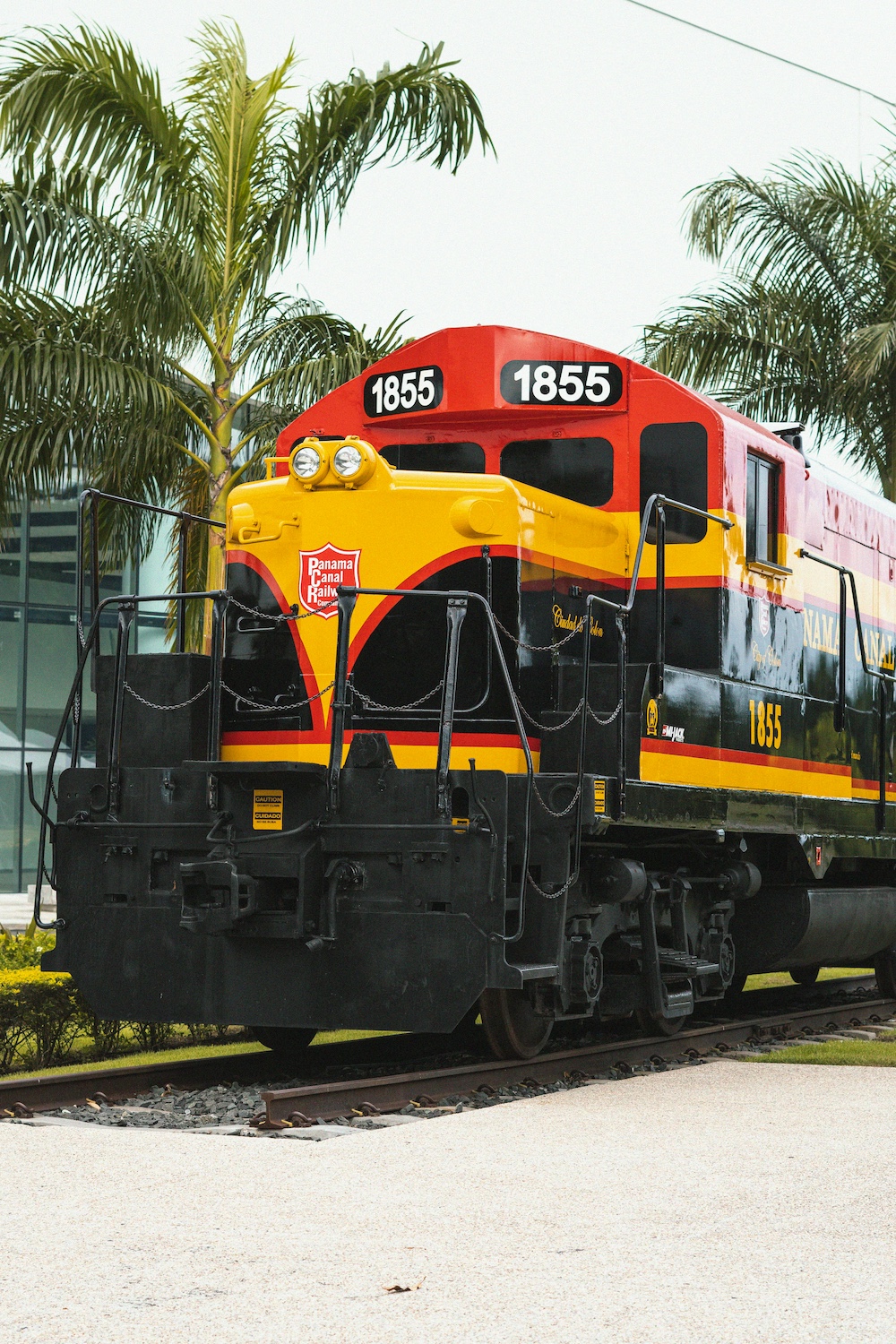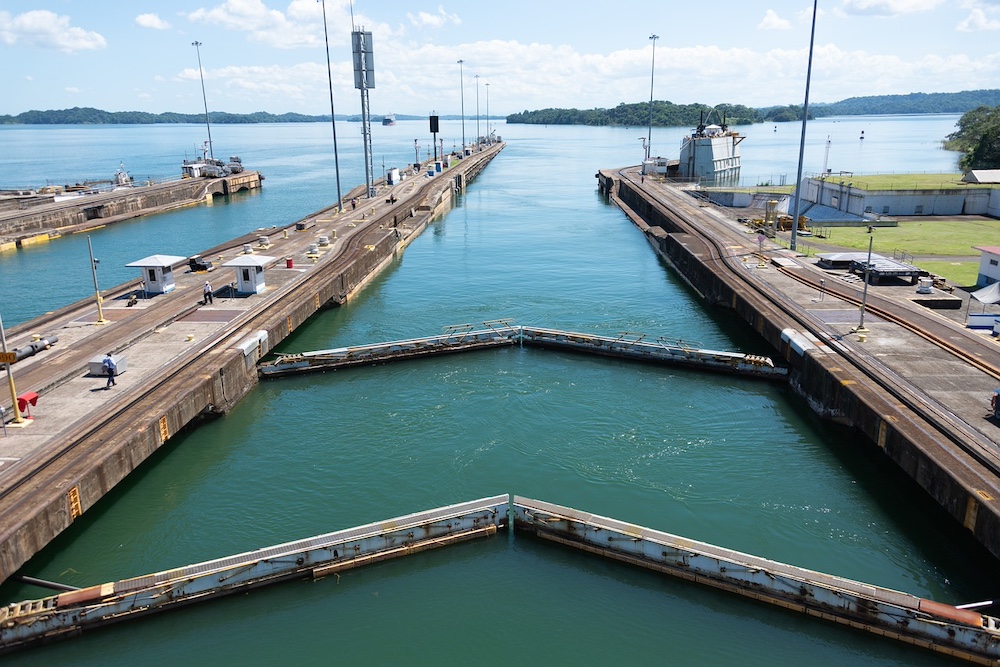Almost everybody that comes to Panama wants to visit the Panama Canal. This iconic sea crossing would be our equivalent to Paris’ Eiffel Tower. Gustave Eiffel was actually involved in the building of our canal, including the scandal known as the “Panama affair” where he was prosecuted along with Ferdinand de Lesseps and his son Charles. You can visit a lighthouse built by Eiffel in Isla Grande and stop by the new Agua Clara locks on the way.
Read our article: 5 Ways to Visit the Panama Canal
Crossing the Panama Canal takes ships an average of 11.38 hours. Ships go “southbound” or “northbound” depending where they start. There is one set of locks in the Atlantic side called “Gatun Locks” and two sets of locks in the Pacific side called “Miraflores Locks” and “Pedro Miguel” Lock. “Agua Clara” is the new set of locks in the Atlantic side after the expansion. You can watch all four locks live on the Panama Canal Authority website.
Ships must pay a toll to cross which is set by the Panama Canal Authority depending on the size, vessel and cargo type. The average toll is around $54,000. An American called Richard Halliburton paid .36 to swim the canal in 1928, making this the lowest toll in history. 14,080 transits were done in 2023 from ships of 180 countries.
The Path Between the Seas: The Creation of the Panama Canal, 1870-1914
French Canal Attempt (1881-1899)
The idea of building a canal started from the time of the Spanish conquistadors. Charles V, King of Spain, ordered a survey to find the route best suited to cross the Americas. Going through the Strait of Magellan, under Argentina and Chile, was quite dangerous for ships. The Spaniards had discovered gold in Peru and needed a route to transport it back to Spain.

Before the Panama Canal two routes were used to cross the isthmus which were the Camino de Cruces (used between 1521 to 1935) and the Camino Real (used between 1533 to 1912). Gold was discovered in California in 1848, and once again there was an interest in crossing the isthmus of Panama. The United States started the contraction of the Panama Railway in 1850, which began its operation in 1855.
Ferdinand de Lesseps was a French diplomat who built the Suez Canal in Egypt. He became quite famous after his success, allowing him to raise the funds to build the Panama Canal. This route through the isthmus was a lot shorter than the Suez Canal. However, the tropical climate and mountains presented a lot more challenges than the flat desert.
He visited the isthmus in the dry season (which is only four months) so he and his men were completely unprepared for the rain. Thousands of workers died because of tropical diseases such as yellow fever and malaria, whose cause was unknown at the time. It wouldn’t be until the Americans took over that Coronel William C. Gorgas would discover that the mosquitos transmitted the diseases.
The rainy season would raise the Chagres River by 10 meters (33 feet). But the biggest challenge was the Culebra cut and Lesseps stubbornness to build the canal at level instead of using locks. The French Canal Company (its headquarters is now the Panama Canal Museum) went bankrupt after spending 287 millions. 800,000 investors lost their money and around 22,000 men died from accidents and disease. The Plaza of France in Casco Viejo pays homage to the French attempt to build the canal and all those who lost their lives.
From France to the United States
A new French company was created to take over the project with Philip Bunau-Varilla in charge. He managed to convince Lesseps that a lock and lake canal was more suitable for Panama. This new company was looking for a buyer to take over the project for 109 millions. The United States had interest in this Panama Canal project, but there was another group that favored building the canal in Nicaragua. A stamp with a volcano was used to push for the Panama route since this country had no volcanoes or natural disasters.
The United States senate voted in favor of the Panamanian option with the Spooner Act in June of 1902. At that time Panama was part of the Great Colombia, which originally included Colombia, Venezuela, Ecuador and Panama. At that time it was just Panama being managed by Colombia. The Hay-Herran Treaty was signed on January 22, 1903, giving Colombia 10 million in compensation and an annual payment. But the United States was asking for land around the Panama Canal for 100 years renewable. This part was extremely unpopular, so the Senate of Colombia voted not to ratify the treaty on March 14.
Theodore Roosevelt with help from the JP Morgan firm (read How Wall Street Created a Nation: J. P. Morgan, Teddy Roosevelt, and the Panama Canal), who had a stake in the French company, decided to take a new approach and change the history of the Panama Canal. For them it would be easier to get Panama to become an independent nation. So they sent warships on both sides of the country to control the Colombian troops. Panama became its own country on November 3, 1903 (read about Panama’s Independence Holidays). The United States recognized Panama as its own country.
Philippe Bunau-Varilla was named as Panama’s ambassador to the United States. He went to the United States to sign the Hay-Bunau-Varilla treaty which granted rights to the United States to build the Panama Canal, as well as to have a Panama Canal Zone for perpetuity. My great grandfather was Federico Boyd, one of the founding fathers of Panama. He was part of a delegation that went to the United States but he arrived after the treaty was signed. Which was signed by a French and an American, no Panamanian. My family says he punched Bunau-Varilla once he found out.
United States Construction (1904-1914)
On May 4, 1904, the United States formally started the construction of the Panama Canal. They set up the Isthmian Canal Commision (ICC) which reported directly to William Howard Taft, secretary of war. John Frank Stevens, was appointed after the first chief engineer quit, he had built the Great Northern Railroad. He ignored the ICC which was too bureaucratic and reported directly to the Roosevelt administration. Stevens set up the proper infrastructure for people to be able to work by creating housing, hotels, restaurants, warehouses, repair shops and water systems.
Thousands of workers from the Caribbean came to work in the construction. These “Afro – Panamanian” contributed to improving the local gastronomy. Stevens also enlarged the Panama Canal Railway and got it to be operational once more. This railway was used to move tons of soil from the mountains. This soil was used to build the Amador Causeway in Panama City. Coronel William C. Gorgas used Carlos Finlay and Walter Reed’s work to control mosquitos in order to stop the spread of diseases which took two years. Even so, over 5,500 workers lost their lives due to diseases and accidents.

Stevens, who had seen the rise of the Chagres River, told the United States government that a sea-level canal was impossible. He proposed using a set of locks to raise and lower ships using a large man made reservoir of water which was the Gatun Lake. They created the largest dam and lake to be able to achieve this feat. Those who do the Monkey Island Tour or the Panama Canal Transit will pass through the Gatun Lake.
The United States brought down new machinery to be able to excavate 17 million cu yd (13 million m3) more than the French had already excavated. In 1907, General George Washington Goethals replaced Stevens. He managed to complete the Panama Canal construction in 1914, two years before its expected completion date. The Panama Canal opened officially on August 15, 1914, with the passage of the SS Ancon. 500 million was the cost of building this canal (about 15.2 billion in 2023).
The Madden Dam (now known as Lake Alajuela) was created in 1935 across the Chagres River above Lake Gatun to help secure additional water for the canal lock system.

Modern History of the Panama Canal

Tensions regarding the Panama Canal Zone escalated after World War II. Many Panamanians thought the Hay-Bunau-Varilla treaty was unfair. Students protested about the loss of sovereignty which ended up with the death of 20 Panamanians on January 9, 1964. 10 years later, in 1974, the United States government negotiated a new treaty called Torrijos-Carter which was signed on September 7, 1977 by Omar Torrijos and Jimmy Carter. This treaty would transition the canal back to Panama on December 31, 1999.
The Panama Canal Authority was established in order to take over the job of management. While the lands which belonged to the United States were being passed over to the government of Panama as soon as the treaty was signed.
The idea of building a new set of locks started in 1939. These locks would be large enough to pass warships, but the started project was cancelled after World War II. Panama held a referendum in 2006 where Panamanians had to vote to approve the canal expansion. The majority of citizens voted in favor. This would be the largest modernization plan in 92 years with a cost of 5.25 billion.
By 2011, 37% of ships would be too large for the old canal. Failure to expand would mean a huge loss of profit. Already 50% of the boats that were passing used the full width of the locks. The expansion of the Panama Canal was done between 2007 and 2016. Unlike the US construction, the expansion project was delivered two years late and there were a lot of issues with the construction consortium.
Our canal is a sense of pride for Panamanians everywhere. Visitors should go to one of the visitor centers or do a tour in the Panama Canal.
As an Amazon Associate I earn a small commission if you click on our links and make a purchase at no additional cost to you. This helps me to provide valuable content.
